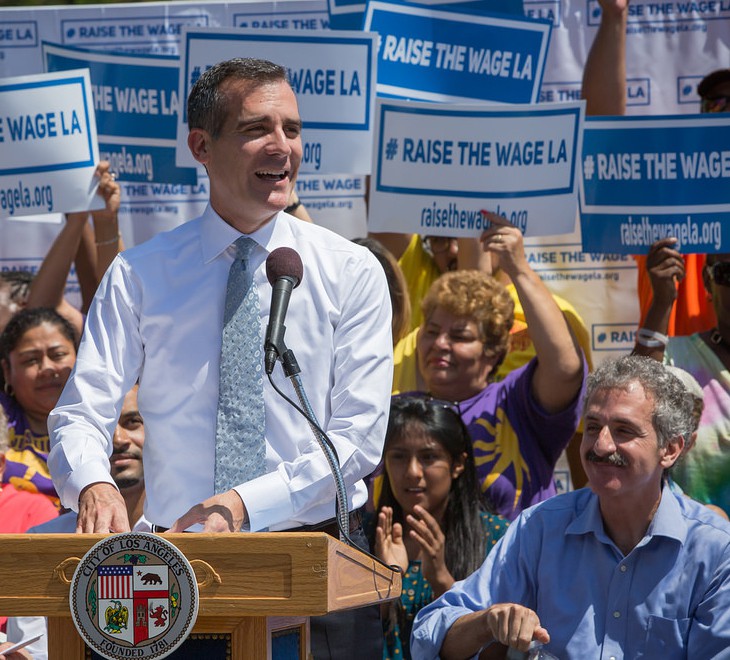FOR IMMEDIATE RELEASE
CONTACTS: Daniel Flaming, danflaming@economicrt.org, 213-892-8104
Patrick Burns, patrickburns@economicrt.org, 213-892-8104
“Global shipping corporations are incredibly powerful. Preserving good wages and benefits is a constant struggle, especially for those who don’t have the support of a union. I’d like to see workers treated with respect and dignity, and truly valued. Not just longshore workers, but all workers.” Sal DiCostanzo, ILWU dockworker and Local 13 executive board member
Researchers at The Economic Roundtable found that the publicly owned Ports of Los Angeles and Long Beach are capital-intensive facilities that have become profit centers for foreign supply chains at the expense of California’s economy.
LOS ANGELES – Thursday the Economic Roundtable released an independent research report, Someone Else’s Ocean, analyzing cargo operations and jobs at the San Pedro Bay Ports of Los Angeles and Long Beach. The current agreement between the International Longshore and Warehouse Union and terminal operators at all of the 29 West Coast ports ends July 1.
The San Pedro Bay ports are the gateway for 40 percent of goods imported into the United States. They are legally mandated to provide economic and environmental benefits for Californians.
In recent times the American factories and jobs that were supported by the ports have closed and been replaced by warehouses and trucking companies that often pay low wages. Dock jobs are the remaining economic benefit for port communities that bear the impacts of shipping.
Foreign shipping companies that have consolidated into three international shipping alliances control 83 percent of all global container movement. These companies own nine of the 11 container terminal operators at the two ports. These foreign-owned terminal operators handled 81 percent of the containers transported through the ports in 2021.
“Ports should be two-way gates – goods enter and they leave. But in the San Pedro Bay, foreign shippers kicked the gate until it broke – goods are coming in but not going out, harming the environment and the economy,” said Daniel Flaming, one of the authors of the report.
Most cargo comes through major shipping lanes that connect Asian manufacturers with North American consumers. More cargo volume, lower shipping costs and larger vessels are considered better from a business perspective. The negative costs from this model are offloaded onto California communities and businesses.
In 2021, shippers paid less to return empty containers than they would have if the containers held American cargo. Seventy-two percent of the exported containers were empty.
This trade imbalance is more than five times worse at the Ports of Long Beach and Los Angeles than at the rest of the nation’s seaports, with $8.42 of imports for every $1.00 of exports. China, the largest supplier of imports (42 percent), sent $12 of imports to the San Pedro Bay Ports for every $1 of exports they received.
Despite American technological excellence, the U.S. imported 25 to 35 times more industrial machinery, electrical equipment, and instruments than we exported. The challenge for the ports is to ensure that transportation logistics create as much benefit as possible and as little loss as possible for California workers and their communities.
Rebalancing California’s interests against the interests of foreign shippers includes using the ports’ logistical assets to support reshoring of critical manufacturing industries that align with U.S. “super preferences” for domestic technology and the recently invoked Defense Production Act to accelerate clean energy manufacturing.
“We believe that worker solidarity, unionism, and robust collective bargaining are key to achieving a better life,” said Frank Ponce De Leon, ILWU Coast Committeeman. “It is crucial that the privately operated terminals at our publicly-owned ports provide economic security for every worker who moves cargo and support the communities that endure the inevitable downsides of shipping, like traffic and infrastructure costs.”
In a typical year, 13,000 workers are employed on the San Pedro Bay docks, some full-time, others part-time. There are roughly 19.5 million hours of work moving cargo through the ports, with wages of roughly $1.2 billion for this work.
The average hourly wage for all hours worked in the ports in 2021 was $62.44. Dockworkers perform high-value-added work and a strong union represents them. They are well paid and bring significant economic benefits to their communities.
Non-port businesses and their workers benefit from the household spending of dockworkers, which supports an additional 7,065 year-round jobs and $1.376 billion in sales.
The International Transportation Forum found that the productivity of automated ports is 7-15 percent lower than for non-automated ports. Automation, however, enables foreign shippers to deliver their products to American consumers without relying on American dockworkers.
Automation at two San Pedro Bay terminals has eliminated 572 full-time dockworker jobs along with an additional 254 jobs and $50 million in sales at stores where dockworkers spend their wages.
“The wages lost because of automation are devastating for dockworkers and their families. Restaurants in San Pedro, doctor’s offices in Long Beach, grocery stores in Wilmington, and businesses across the state are also hurt by lost wages on the docks,” said Patrick Burns, another of the report authors.
Despite their increasing profits, foreign owners failed to pay an estimated $279 million uncompensated public costs in 2021 from 6.7 billion ton-miles travelled by trucks leaving the San Pedro Bay Ports carrying imported containers. Negative impacts on port and regional communities need to be offset by increasing the economic benefits generated by the ports.
The report recommends renegotiating the lease agreements between the publicly owned ports and private terminal operators to incentivize exports, recouping uncompensated public costs, enacting taxes on automated equipment, and provide living-wage compensation for all port-linked jobs, including truck drivers.
The report analyzes leases and revenue for container terminal, records for each vessel that has docked since 2013, and the containers imported and exported. In addition, the report analyzes Pacific Maritime Association data, including over 25 million records for every job shift of dockworkers since 2010. The report also analyzes U.S. customs data.
The Coast Longshore Division of the International Longshore and Warehouse Union underwrote this independent research report.
The report can be downloaded at: https://economicrt.org/publication/someone-elses-ocean/
ABOUT THE ECONOMIC ROUNDTABLE
The Economic Roundtable is a nonprofit urban research organization based in Los Angeles that carries out large-scale data analyses to identify actionable solutions to social, economic and environmental problems. To learn more, please visit http://economicrt.org/.
###############













